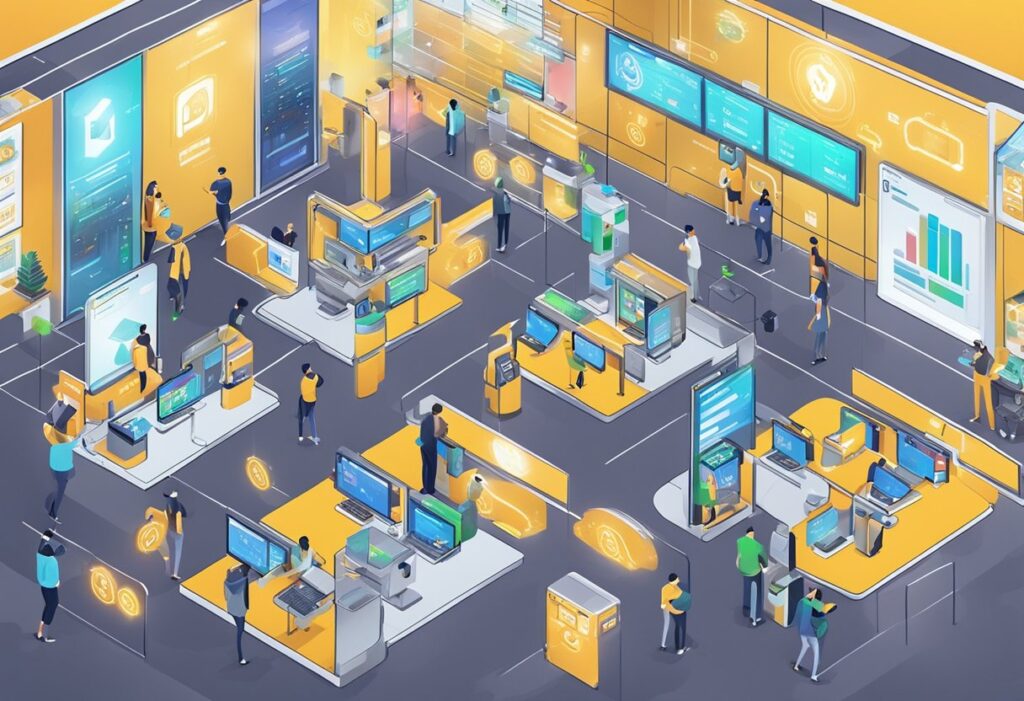The concept of the metaverse has been gaining traction in recent years, and it has now made its way into the world of banking. The metaverse is essentially a virtual world that exists parallel to the physical world, and it is created by the convergence of various technologies such as the internet, virtual reality, and blockchain. The potential for the metaverse in banking is vast, and it could revolutionize the way we interact with financial institutions.
One of the main advantages of the metaverse in banking is the potential for increased accessibility. With the metaverse, customers can interact with their banks from anywhere in the world, as long as they have an internet connection. This could be especially beneficial for people who live in remote areas or have mobility issues. The metaverse could provide a more immersive and engaging experience for customers, making it easier for them to understand complex financial concepts.
Technology is at the heart of the metaverse in banking, and it is what makes this concept possible. Banks will need to invest in cutting-edge technologies such as virtual reality and blockchain in order to fully take advantage of the metaverse. With the right technology, banks can create a seamless and secure virtual environment for their customers to interact with their financial products and services.
The Rise of Metaverse Banking
Metaverse banking refers to the integration of virtual reality, blockchain technology, and artificial intelligence into the banking industry. It is a new way of banking that offers customers a unique experience by providing them with a virtual branch where they can carry out banking transactions. Metaverse banking enables customers to interact with their banks in a virtual world, allowing them to access banking services from anywhere in the world.
Current Landscape and Key Players
As more banks start to think about their metaverse strategy, one thing is clear. The metaverse and Web3 represent the next generation of the internet and will reshape the way business and customers engage, socialize and work. Several banks such as HSBC, Citi, Bank of America, JP Morgan, Siam Commercial Bank, and Kookmin Bank are already exploring the potential of metaverse banking.
HSBC has already created a virtual branch in Second Life, a popular virtual world. The virtual branch allows customers to interact with bank representatives, access account information, and carry out transactions. Citi has also launched a virtual branch in Second Life, providing customers with a unique banking experience.
Transforming Customer Experience
Metaverse banking is transforming the way customers interact with their banks. It offers customers a unique experience by providing them with a virtual branch where they can carry out banking transactions. Customers can interact with bank representatives, access account information, and carry out transactions from anywhere in the world.
Metaverse banking also offers customers the ability to customize their banking experience. Customers can choose their avatars, create their virtual environments, and interact with other customers in the virtual world. This creates a more engaging and interactive banking experience, which is more appealing to younger customers.
Metaverse banking is the future of banking. It offers customers a unique experience by providing them with a virtual branch where they can carry out banking transactions.
The integration of virtual reality, blockchain technology, and artificial intelligence into the banking industry is transforming the way customers interact with their banks. As more banks start to explore the potential of metaverse banking, it will become more prevalent in the banking industry.
Technological Foundations

The metaverse is built on a foundation of advanced technologies that are rapidly evolving to meet the needs of users. These technologies are primarily focused on creating immersive and interactive experiences that blur the lines between the physical and virtual worlds. In this section, we will explore some of the key technological foundations of the metaverse, including blockchain and decentralized technologies, virtual reality and augmented reality, and artificial intelligence and internet of things.
Blockchain and Decentralized Technologies
Blockchain technology and other decentralized technologies are critical components of the metaverse. These technologies provide a secure and transparent way to store and transfer digital assets, such as virtual currencies and digital identities. Decentralized ledger technologies (DLT) allow for the creation of decentralized applications (dApps) that can be used to create new financial services and other applications in the metaverse.
Virtual Reality and Augmented Reality
Virtual reality (VR) and augmented reality (AR) are spatial technologies that create immersive and interactive experiences in the metaverse.
VR allows users to enter fully immersive virtual environments, while AR overlays digital content onto the physical world. These technologies enable users to interact with digital content in new and exciting ways, creating new opportunities for financial services and other applications.
Artificial Intelligence and Internet of Things
Artificial intelligence (AI) and internet of things (IoT) technologies are also critical components of the metaverse. AI can be used to create intelligent virtual assistants and other applications that can help users navigate the metaverse. IoT technologies can be used to create smart devices that can interact with the metaverse, creating new opportunities for financial services and other applications.
The metaverse is built on a foundation of advanced technologies that are rapidly evolving to meet the needs of users. These technologies include blockchain and decentralized technologies, virtual reality and augmented reality, and artificial intelligence and internet of things. By leveraging these technologies, financial services and other applications can create new and exciting experiences in the metaverse.
Financial Products and Services in the Metaverse

As the metaverse continues to evolve, financial institutions are exploring new ways to offer innovative products and services to their customers. Here are some of the financial products and services that are being offered in the metaverse.
Digital Assets and Cryptocurrencies
Digital assets and cryptocurrencies have become a popular investment option in the metaverse. Many virtual worlds have their own digital currencies, which can be used to purchase virtual goods and services. In addition, some virtual worlds allow users to trade digital assets and cryptocurrencies with other users.
Innovative Lending and Investment Services
Lending and investment services have also become more innovative in the metaverse. Some virtual worlds offer peer-to-peer lending platforms, which allow users to lend and borrow virtual currencies. In addition, some virtual worlds offer investment opportunities in virtual real estate and other virtual assets.
Metaverse Exclusive Offerings
Some financial institutions are offering metaverse-exclusive products and services. For example, Nike has released a limited edition virtual sneaker in Decentraland, which can only be purchased using the virtual currency of the world. In addition, some virtual worlds have their own marketplaces, where users can buy and sell virtual goods and services.
The metaverse offers a new frontier for financial institutions to offer innovative products and services to their customers. As the metaverse continues to evolve, it will be interesting to see what new financial products and services will be offered in the future.
Security and Compliance in Metaverse Banking

As the metaverse becomes an increasingly popular platform for banking, security and compliance have become critical concerns for financial institutions. Banks must implement risk management strategies, identity verification and fraud prevention measures, and regulatory compliance and data protection policies to ensure the safety of their customers’ assets and information.
Risk Management Strategies
Banks must develop risk management strategies to protect their customers and their own assets from potential threats in the metaverse.
This includes assessing the risks associated with digital assets and implementing appropriate controls to mitigate those risks. Banks must also monitor their systems and networks for unusual activity and respond quickly to any potential security breaches.
Identity Verification and Fraud Prevention
Identity verification and fraud prevention are critical components of metaverse banking. Banks must implement robust identity management systems to ensure that only authorized individuals have access to their customers’ accounts. This includes using multi-factor authentication and biometric verification methods to prevent unauthorized access. Banks must also implement fraud management systems to detect and prevent fraudulent activity in real-time.
Regulatory Compliance and Data Protection
Regulatory compliance and data protection are essential for banks operating in the metaverse. Banks must comply with all relevant regulations, including the ERC 725 standard for identity management and the General Data Protection Regulation (GDPR) for data protection. Banks must also implement appropriate data protection measures to ensure the confidentiality and integrity of their customers’ information.
Goldman Sachs and Morgan Stanley are among the banks that have already begun to explore the potential of metaverse banking. However, as with any new technology, there are risks and challenges that must be addressed. Banks must take a proactive approach to security and compliance to ensure that they can safely and effectively operate in the metaverse.
Future of Banking in the Metaverse
As the concept of the metaverse continues to gain momentum, it is clear that it will have a significant impact on the banking industry.
The metaverse has the potential to reshape the way business and customers engage, socialize, and work. In this section, we will explore the predictions and emerging trends, as well as the challenges and considerations that the banking industry must address in order to thrive in the metaverse.
Predictions and Emerging Trends
The metaverse is an emerging concept that is still in its early stages. However, it is expected to grow and evolve rapidly in the coming years. One of the most significant trends in the metaverse is the rise of the metaverse economy. This economy will be powered by virtual currencies and will allow users to buy and sell virtual goods and services. Banks will need to adapt to this new economy and develop new products and services that are tailored to the metaverse.
Another emerging trend in the metaverse is the use of avatars. Avatars are digital representations of users that can be customized to reflect their personalities and preferences. Banks can use avatars to engage with customers in the metaverse and provide personalized services. Banks can use avatars to design virtual branches that are more engaging and user-friendly than traditional banking branches.
Challenges and Considerations
While the metaverse presents exciting opportunities for the banking industry, it also presents significant challenges and considerations. One of the biggest challenges is the risk of cyberattacks. The metaverse is a digital environment, and as such, it is vulnerable to cyberattacks. Banks will need to develop robust cybersecurity measures to protect their customers’ data and assets.
Another consideration is the need for new skills. The metaverse requires a new set of skills that are different from those required in traditional banking. Banks will need to invest in training their employees to develop the necessary skills to thrive in the metaverse.
Finally, banks will need to consider the risks associated with brand extension. The metaverse is a new and emerging environment, and banks will need to be careful not to damage their brand by engaging in inappropriate or risky activities. Banks will need to develop clear guidelines and policies for engaging in the metaverse and ensure that they are aligned with their overall brand strategy.
The metaverse presents significant opportunities and challenges for the banking industry. Banks that are able to adapt to the metaverse and develop new products and services that are tailored to this environment will be well-positioned to succeed in the future. However, banks must also be aware of the risks and challenges associated with the metaverse and take steps to address them.
Frequently Asked Questions

How are banks leveraging the metaverse to enhance customer experience?
Banks are leveraging the metaverse to enhance customer experience in several ways. One of the most significant ways is by creating virtual branches and ATMs in the metaverse. This allows customers to access banking services from anywhere in the world, at any time. Banks are using virtual reality technology to create immersive experiences for customers, such as financial education and investment simulations.
What innovative services are being offered by banks within the metaverse?
Banks are offering a variety of innovative services within the metaverse, including virtual loans, virtual credit cards, and virtual insurance policies. These services are designed to provide customers with greater convenience and flexibility when it comes to managing their finances.
Which financial institutions have made significant investments in metaverse technology?
Several financial institutions have made significant investments in metaverse technology, including JPMorgan Chase, Goldman Sachs, and Wells Fargo. These institutions are investing in the development of virtual branches, ATMs, and other innovative services that will allow them to better serve their customers in the metaverse.
What potential benefits does the metaverse offer to the banking sector?
The metaverse offers several potential benefits to the banking sector, including increased accessibility, greater efficiency, and improved customer engagement. By leveraging metaverse technology, banks can provide customers with 24/7 access to banking services, reduce costs associated with physical branches, and create immersive experiences that promote financial literacy and engagement.
What are the primary security concerns for banking activities in the metaverse?
The primary security concerns for banking activities in the metaverse include identity theft, fraud, and cyber attacks. Banks must take steps to ensure that customer data is secure and that transactions are conducted safely and securely.
How might regulations shape the future of banking in the metaverse?
Regulations are likely to play a significant role in shaping the future of banking in the metaverse. As the metaverse continues to evolve, regulators will need to develop new frameworks for ensuring that customer data is protected, transactions are secure, and financial institutions are held accountable for their actions.














